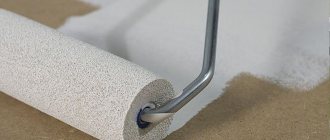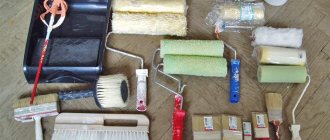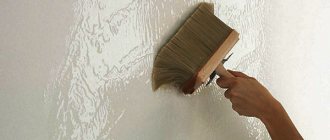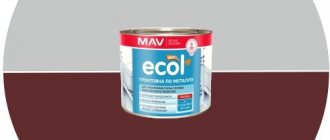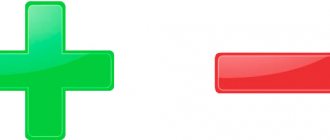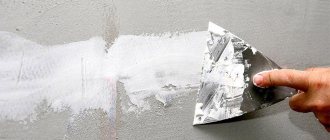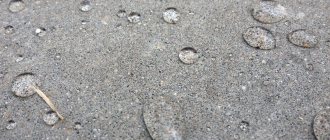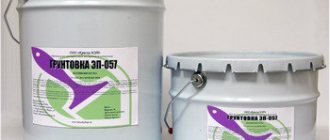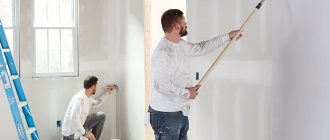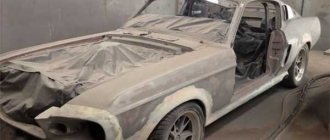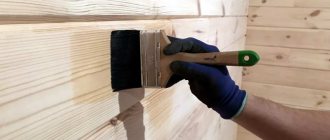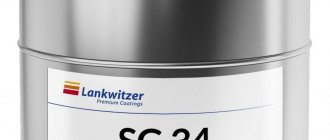The main purpose of primers is to treat the surface before finishing. The consumption of materials for the finishing coating depends on it. For example, priming the walls before painting is mandatory. There are many types of such compounds, including polyurethane. Polyurethane is a polymer material that belongs to the group of synthetic elastomers.
Primers of this type perfectly protect the surface and strengthen the base. That is why they have become so widespread. The chemical composition is absorbed into the walls, increasing the surface’s resistance to moisture and corrosion. In addition, polyurethane-based primers have a high degree of adhesion. Their production uses polyurethane raw materials with additives in the form of solvents.
How to apply to the surface correctly
The method for applying primers with polyurethane is simple, it is almost no different from applying other primers, only its structure is not suitable for using a spray gun. You can apply the solution:
- Rollers of various sizes. They can quickly and evenly paint a large area.
- With brushes. It is better to use them as an aid for painting hard-to-reach places - treating large areas with them takes a lot of time.
The primer mixture can be applied to an uncleaned surface, but for better “setting” the area to be treated is desirable:
- clean from dust and remnants of old finishing;
- wash;
- dry and degrease;
- repair large cracks; small ones can be left - the polymer mixture will evenly fill them, leveling the surface.
After such preparation you can prime:
- The solution is evenly distributed over the entire area using a roller.
- After complete drying (after 3-5 hours), you can apply a second layer. It should be remembered that you need to work crosswise, that is, if during the first priming the direction of movement was vertical, then when applying the second layer the roller should move in a horizontal direction, this will ensure the most uniform impregnation. As a rule, a third layer is not required, and after drying you can begin decorative finishing.
Applying a polyurethane substance to concrete
The technique for working with polyurethane primers is similar to working with other compounds. The only thing is that they cannot be applied using a spray gun. For concrete surfaces, rollers are chosen, which should be of different sizes. They help cover the surface in a short time.
For hard to reach places you will need brushes.
For concrete surfaces, rollers are chosen, which should be of different sizes.
Primer for concrete floors, application technology and preparation of coatings
The instructions say that you can use many of these types without preparation. However, the best results are achieved when the preparatory work is completed. The following phases are distinguished:
- Remove old coating.
- The surface has been washed.
- Wait until it is completely dry.
- Large imperfections are filled with putty, small ones are leveled with a primer solution.
After this, they are treated with a solution prepared using rollers; before applying the 2nd layer, they wait about 5 hours before applying a new one. The first layer is applied vertically, the second - horizontally. The second layer becomes the finishing layer.
Before applying the 2nd coat, wait about 5 hours before applying a new one.
Features of concrete primer for exterior use
To obtain a reliable coating when working outdoors, the following requirements should be taken into account when choosing a composition:
- When working with a metal base, compositions with anti-corrosion properties are selected;
- a solution containing many adhesive and film-forming elements is required.
- Resistance to environmental factors;
- Presence of antiseptic elements;
a solution containing many adhesive and film-forming elements is required.
Advantages and disadvantages
Thanks to the primer, concrete acquires an impeccable surface; in addition, the mixture helps make adhesion to subsequent decorative coatings - varnish, paint, enamels - more reliable.
Polyurethane-based primer mixtures are considered the best for priming work, as they have many advantages over other compounds.
- Polyurethane primer goes well with any base that has a porous structure with high absorbency. Therefore, it is used not only for priming concrete, but also for surfaces made of wood, metal, and brick.
- Polyurethane can be used to treat floors with heating on.
- This material is not a problem even if there are dust particles on the base. The primer can be applied to a slightly cleaned surface, and the binding of dust particles will occur during the hardening process.
- One of the important positive qualities of the primer is the possibility of interior and exterior finishing.
- When compared with compounds of the same purpose, polyurethane is a more economical material. Of course, the consumption depends on the depth to which it penetrates into the thickness of the product, but in any case, per 1 sq. m of surface, from 200 to 500 grams of polyurethane mixture are spent, and other compositions - 2-3 times more.
The primer mixture has some minor disadvantages, but they are not so critical:
- the drying time for most such compositions is 2 hours, and polyurethane will take from 3 to 5 hours to harden;
- the application procedure is carried out manually, since it is not possible to use a sprayer;
- polyurethane has a relatively high price (but we must not forget that the coating has good wear resistance and durability, and the long service life is well worth the money).
Advantages and disadvantages
The composition has a number of advantages:
- It is allowed to use this material on an unprepared surface. There is no need to clean it from dust. The components of the solution will bind the dust and make the coating even stronger.
- You can apply the primer to the floor with the heating on. It should be noted that this option is only possible in the case of polyurethane materials. Other solutions will negatively affect the surface.
- Polyurethane material is universal. Its scope is not limited to interior decoration; it can also be used outside.
- Very economical consumption. The standard primer consumption is approximately 0.8 kg/m2. And for polyurethane - from 200g to 500g/m2.
- Suitable for use on substrates such as wood, concrete, metal. If the surface absorbs moisture well, then the primer will be absorbed well.
- The following work on strengthening the walls can not be carried out soon, since the primer mixture is reliable and durable.
Despite the fact that this is a very high-quality composition, it also has a number of disadvantages:
- Extremely long drying time . It can take from three to five hours. In this case, the remaining solutions are absorbed within a few hours.
- High price level for materials. The cheapest composition can be found at a price of 200 rubles per kilogram. But here everything depends on the manufacturer and the quality of the chemical components. Prices for some primers start at 5,000 rubles per kilogram. It should be noted that the repair work carried out will not have to be repeated soon, therefore, in particularly difficult cases, such a price is justified.
Varnishing
After painting, in most cases it is also necessary to varnish the product. The first layer of varnish, prepared for use, is applied at the same rate as primer (150 g per 1 sq. m).
The second layer is applied after the first layer has completely dried. Then, when this paint dries, you need to sand the MDF panel again. First, coarse-grain sandpaper is passed over its surface, and then fine-grained sandpaper is used. To prevent lumps from rolling off, the treated area is periodically moistened with water.
Another week after this, the MDF must be additionally polished with a sander and abrasive paste. This is the most correct technology, although at home, when working with your own hands, it is sometimes not followed, limiting yourself to ordinary varnishing.
Premises
- Home flooring for: apartment, kitchen, nursery, shower, bathroom, balcony
- Industrial self-leveling floors for: garage, parking lot, parking lot, car wash, workshop, car service, warehouse, entrance.
- Self-leveling floors for: restaurants, medical institutions, schools, exhibition centers, swimming pools, shops and shopping centers, offices, laboratories, train stations, sports floors.
- Floors of industrial buildings for: mechanical engineering, electronics, food, dairy, fishing, pharmaceutical industries, in workshops of industrial premises.
What are they?
Epoxy primer mixtures have some differences in composition, which affects their basic technical characteristics.
The classification of soil is influenced by the following factors:
- the material from which the structure to be processed is made: concrete or metal;
- temperature regime at which the mixture begins to harden;
- components that are included in the composition as a hardener;
- Possibility of use with various paints and varnishes;
- According to their composition, one-component and two-component types are distinguished;
- manufacturer.
One-component
Epoxy resin-based primer is most often produced in the form of a two-component mixture. The exception is epoxy mixtures, which are applied as a preliminary coating to the car body. Basically, one-component primer is produced in the form of an aerosol.
In many respects, the material is inferior to two-component mixtures, so it is not very popular among car owners.
In addition to its main purpose, a one-component concrete mixture can be used for wood processing. Wood structures coated with epoxy acquire good moisture resistance.
In addition, one-component solutions are used for complex concrete bases and to improve the level of adhesion with such materials as:
- ceramic tile;
- tree;
- linoleum.
Two-component
Two-component mixtures are most popular for working on metal and concrete. It is believed that this composition has better quality and higher performance characteristics than a one-component primer.
Car owners prefer this type of primer. In addition to the excellent protective properties of the coating, two-component compositions for cars can be painted with special pastes to improve the color of the final paint layer.
For metal
Epoxy primer for metal surfaces, first of all, has good anti-corrosion properties. In addition to epoxy resins, this mixture contains elements such as zinc and phosphoric acid, due to which the soil prevents the formation of corrosion. Epoxy resin-based metal primer is mainly available in two-component form.
If necessary, you can cover the layer of epoxy mixture with an acrylic-based primer.
Zinc-rich
A two-component zinc-rich mixture based on epoxy resin is used as a coating for subsequent painting with epoxy and polyurethane paints. This material can also be used as a finishing coating for metal structures that are exposed to the negative effects of the external environment.
Due to the high content of zinc elements, this primer perfectly protects steel surfaces from corrosion. This coating will last more than ten years as a base layer and more than twenty years in combination with other protective compounds.
For concrete
Epoxy primer is used to treat concrete floors and walls. In turn, mixtures for concrete have their own classification:
Features of concrete primer for exterior use
The selection of polyurethane primers for exterior work should be done responsibly. They have a lot of requirements that can affect the quality and durability of surface finishes.
Polyurethane primers for exterior finishing must meet the following requirements:
- They must have increased resistance to atmospheric influences. The material must easily withstand precipitation, rain, snow, and withstand sudden temperature changes and freezing;
- The composition must contain antiseptic components. They will protect against mold and fungal formations;
- If metal elements are provided, then for processing it is recommended to use primer mixtures with the addition of rust inhibitors and antioxidants;
- The composition of polyurethane primer for external work should be dominated by adhesive and film-forming components. This will reliably strengthen the base.
Different types of compounds
There are the following types of polyurethane-based compounds:
- single-component, which consist of a main component and a solvent. Basically, one-component polyurethane primer, such as vl, is used for interior priming, for treating wood and MDF boards, and it is also used for coating concrete bases. Its main purpose is to increase the adhesion rate, strengthen the base, level the surface before applying the finishing finish;
- a two-component type of polyurethane primer is supplied in two different containers, one of which contains the polyurethane composition, and the other contains the hardener. Before use, both components must be mixed with each other. Polyurethane primers, consisting of two components, are more durable, but have low fluidity due to the fact that the composition contains a hardener. This type is mainly used for priming outdoors, and this polyurethane primer is also used for concrete and floors that can withstand high daily loads. If the soil is zinc-rich, it provides protection to metal products from corrosion and rust.
Two-component primers are very rarely used to coat wood and MDF boards. In cases where priming is the only way to protect the surface, for example, floors in a workshop, it is advisable to use enamel primer to strengthen the concrete base and protect it from destruction.
Soil 1101
Polyurethane primer 1101 is a one-component composition containing organic solvents. Hardens on contact with air. The main properties of this polyurethane primer:
- penetrates deeply into the surface of materials;
- makes the bond between the base and the topcoat very strong;
- significantly increases the adhesion properties of polyurethane products to the surface;
- after the soil dries, the material becomes resistant to mechanical stress, as well as the influence of technical fluids and water;
- It is applied very easily and quickly, the material is completely safe for humans.
Primer 1101 is used for treating porous substrates; it can be applied to concrete, plaster, cement-sand surfaces, wood, shrinkage and expansion joints of concrete floors, before applying polyurethane sealing products.
Primer PU 01
Polyurethane primer PU 01 is a one-component product that reliably fills small pores, significantly increases the adhesion of the base to the polyurethane finish, makes the surface much stronger, and removes dust from the base. It is used for priming surfaces before self-leveling concrete floors, applying protective materials, enamels with a polyurethane or epoxy base.
This type of polyurethane primer has the following advantages:
Varieties
Polyurethane primer for concrete is divided into several subtypes, each of which has its own distinctive features. The following popular varieties with a polyurethane structure are distinguished:
- Acrylic mixtures.
They belong to one-component compositions. They are usually used to treat surfaces made of MDF boards and wood. These impregnations have a deep-penetrating structure; they perfectly fill the wood base and level it. Acrylic mixtures are also often used for concrete surfaces indoors. They strengthen the material, making it more durable;
- Alkyd solutions.
They are great for outdoor woodworking. They provide protection to the top layer from darkening. In order to make the wooden surface more expressive and bright, you can use priming enamels. It will be able to completely saturate the base and become the finishing coating;
- Epoxy paints or primers.
This variety is excellent for treating metal surfaces and protects them from negative external influences. It can be used to protect concrete floors. The solution penetrates into small pores, levels the surface and makes it stronger;
- Primer concrete contact.
Solutions of this type are often used for treating surfaces before laying tiles or for priming plasterboard sheets;
- Adhesive.
After application, it creates a rough layer on the surface, which is of great importance for the full adhesion of materials to a smooth concrete surface.
Paints that can be used
To paint MDF boards yourself, it is best to take enamels, since they form a durable opaque film and come in glossy and matte finishes. The following materials can be used:
- alkyd, alkyd-urethane or oil-based enamels;
- based on polyurethane resins;
- acrylic enamels;
- nitro paints of the NTs series;
- professional two-component polyurethane enamels;
- specialized enamels for MDF;
- automotive enamels.
Each of these materials has its own characteristics. But perhaps the last two items on the list have the best properties.
It is especially worth noting that in industrial conditions today powder coating of MDF facades is often used. This method is extremely economical and makes it possible to achieve high mechanical and chemical costs. The method is based on the ability of unlike charges to attract each other. It was originally used for ceramics, metals and other materials that can withstand high temperatures.
It is now almost impossible to paint MDF facades using a powder method in standard home conditions. This type of painting requires special, expensive equipment that can only pay for itself with constant, frequent use, and it’s unlikely to be placed at home.
How to choose and use an antiseptic primer for wood surfaces?
Antiseptics can be divided into types according to several criteria - these are the components on the basis of which they are made, the area of application of the compositions, and their functionality.
- So, antiseptic impregnations are basically divided into aqueous, oily, organic and combined solutions.
A few words should be said about their characteristics:
Water-based antiseptics are suitable for treating any type of wood, but their scope is still limited
— Water-based antiseptics are used for protective impregnation of wood of any species. For their production, components such as sodium fluoride, sodium silicofluoride, as well as borax and boric acid (BBK3) are used. Water-soluble compounds are most often used to impregnate wooden surfaces, which in the future will not be exposed to intense moisture.
Oil-based impregnations create a good barrier against moisture penetration - an excellent solution for outdoor work
— Oil antiseptics can be called the most popular, since they are able to protect wood from high humidity and moisture penetration into the fiber structure of the material. When an oil-based solution is applied to the wooden elements of a building, they acquire one of the rich dark shades.
This type of impregnation does not dissolve in water, since it is based on shale, anthracene or coal oil. It must be remembered that oil antiseptics do not protect wood from rapid combustion, that is, they are not fire retardants. They have a very pungent specific odor, so they are most often used to impregnate the external surfaces of buildings.
Impregnations based on organic solvents cannot be considered among the most popular, but they are excellent for facades for further painting
— Organic solutions are most often used for impregnation of facade surfaces. As a rule, they are used in cases where wooden walls are planned to be painted, since they create a thin film on the surface that reduces the moisture absorption of wood and increases the adhesion of paints and varnishes.
Prices for Pinotex antiseptics
Antiseptic for wood Pinotex
However, it must be said that they are also suitable for treating interior wooden surfaces, so they can be used for pre-treatment of timber or logs from which walls will be built.
Organic solutions give wood a greenish tint and increase the porosity of the structure. In addition, they can negatively affect metal elements that are fixed to the facade and will come into contact with its surfaces, so the chemical composition can contribute to the activation of corrosion processes.
Combined compositions can provide comprehensive wood protection
— Combined antiseptics have excellent performance characteristics and provide wood with high protection against parasitic microorganisms, mold and fungi. In addition, combined solutions can include components that reduce the flammability of wood, that is, they can act not only as antiseptics, but also as fire retardants. Some formulation options contain coloring pigments and are designed, among other things, to protect wood from ultraviolet rays. Such compositions are rightly considered the most popular - due to their increased versatility.
- According to the area of application, antiseptics can be divided into solutions intended for external and internal work, for dry and wet rooms.
External treatment solutions provide enhanced protection for wood from various negative influences. But their unpleasant odor can significantly “spoil the atmosphere” if they are used indoors.
— Solutions for external work . This category includes antiseptics for preparatory and decorative work, which are highly resistant to aggressive environmental influences, such as ultraviolet radiation, high humidity, freezing, and sudden temperature changes with a significantly large amplitude. Due to the fact that the compositions very often have a strong, unpleasant odor, they are not recommended for use on internal surfaces.
When choosing an antiseptic for interior work, you must also pay attention to the specifics of its use - for dry or wet rooms.
— Antiseptics for interior work . These solutions are made from environmentally friendly components, they do not have unpleasant odors and do not emit toxic fumes into the environment. At the same time, it must be remembered that for rooms in a house or apartment with different levels of humidity, different antiseptics will be required. Manufacturers always place information about their specific purpose on the packaging.
- In addition, antiseptics are divided into therapeutic and prophylactic solutions:
— Medicinal compositions are used in cases where the wood is already damaged by fungus, mold, rot or insects. However, this solution option can also be used for preventive work. Especially in cases where it is planned to operate wooden structures in an aggressive environment, for example, in bathhouses or bathrooms (showers). They are also quite suitable for preventive treatment of facade surfaces.
— Preventive solutions are the most common. It is clear that they are used, as a rule, for processing lumber before the start of construction or during its implementation. Moreover, it is recommended to impregnate the wood immediately after purchasing it.
Antiseptics can be colorless, that is, they do not change the natural shade of the wood, or pigmented, giving the surfaces a certain shade. That is, many compositions can be used both as a primer preparatory layer for painting or other finishing, and as an independent tinted decorative coating.
Primer for self-leveling floor. Types and applications
In general, all types of primer can be divided into two categories:
- dry, which require preparation of the mixture before use;
- liquid, can be used immediately after purchase, do not require special preparation other than mixing.
Universal primer
In turn, these mixtures can be divided into several more types.
Table. Types of primers for self-leveling floors.
| View | Description |
| Mineral | This type of primer is based on ordinary cement. This material is used as a primary material for leveling the base; as it spreads, it carefully covers all defects and levels the floors. Used to cover surfaces made of aerated concrete, expanded clay, concrete, surfaces covered with a layer of plaster. |
| Alkyd | Most often, this primer mixture is used on wooden surfaces, but can also be used on tiles, fiberglass, plastic, and metal. Ideal option for painting. Alkyd primer is not afraid of temperature changes and is stored under almost any conditions (the optimal temperature range varies from -40 to +60 degrees). This material also has restrictions regarding use: alkyd primer is not used on gypsum or plastered and other loose surfaces. This primer layer dries in about a day. |
| Acrylic | Suitable for use on wood or plaster bases. Ideal for applying a finishing layer. Contains graphite, chalk, copper sulfate (the mixture has bactericidal properties and fights microorganisms well). Since the base of such a soil is watery, the surface treated with it dries very quickly - 4 hours is enough. And the material does not have a special smell. This primer should not be used on metal substrates as it may cause rust stains. |
mineral primer
Floor priming
In addition to this classification, primer mixtures can be divided into:
- strengthening, which are used for loose types of base. They have high penetrating abilities;
- ordinary or standard;
- deeply penetrating, which are ideal for plastered surfaces, concrete bases. Excellent increase in adhesion index.
Deep penetration acrylic primer
There are several other types of primer mixtures. This is a biocidal primer, polyurethane, silicone, concrete contact and a material characterized by increased adhesive properties.
Concrete contact
concrete contact
Biocidal primer has the ability to negatively affect various microorganisms, fungus and mold, and protects the floor surface from them. It penetrates deeply into the structure of the base and has a long-lasting protective effect.
Polyurethane-based primer copes well with chemical influences - the surface treated with it will be protected from oil and gasoline stains and is not afraid of solvents. This is an economical option in terms of consumption, but far from the cheapest.
Preparation of the primer mixture
There are also silicone primers that are not at all afraid of moisture. They penetrate very deeply into the surface of the base, while managing to displace excess moisture from it and block access to a new portion of liquid. Silicone primer can be applied to damp screed and also has bactericidal properties.
Concrete contact is a crystallizing primer with increased adhesion properties. But it can only be used in rooms with a certain microclimate. The material does not interfere with the penetration of water, therefore it is not used in bathrooms.
The pigment ensures high-quality treatment of the entire floor
Primers with enhanced adhesion properties (or hydrophobic primers) have excellent adhesion properties, but are susceptible to exposure to various alkaline substances, including those contained in concrete. Because of this, they require periodic updating of the layer.
Dispersion primer Uzin PE 360
Review of popular products and manufacturers
Among the variety of solutions, experts identify several brands that differ in quality. They will be discussed in more detail below.
Primer 1101
It is a one-component, deep-penetrating exterior that improves adhesion to surfaces, ease of use and environmental resistance.
Solid look with deep penetrating properties.
Primer PU 01
Even one-component, it penetrates well into the structure of the material, removes dust from the surface and improves adhesion. It is distinguished by its versatility and speed of drying, it is easy to work with, and the primer is resistant to external influences.
Penetrates well into the structure of the material, removes dust from the surface and improves adhesion.
Stelpant pu zinc
Zinc is added to its composition, which helps to obtain a protective layer against rust formation. Suitable for different materials. Resistant to petroleum elements, has a high degree of adhesion and resistance to environmental influences. Even a one-component solution.
Zinc is added to its composition, which helps to obtain a protective layer against rust formation.
Polyurethane primers are versatile products that can be used in a variety of situations. They offer many benefits and provide durable coverage that will last for many years. In addition, they are easy to apply to the surface, you can do it yourself.
Polyurethane floor primer RTM
When starting work on installing a multilayer polymer coating, it is necessary to prepare the base before applying the polymer layers.
Preparation of the concrete base includes:
- grinding the concrete surface;
- repair of the base or installation of cement screeds if necessary (for these purposes, the RTM company offers repair compounds MAX RS and polymer-cement screeds MAX TOP);
- cutting construction seams;
- dust removal of concrete;
- applying a primer to remove dust, increase the strength of concrete and improve the adhesion of the base and subsequent layers.
The RTM company produces and sells one-component polyurethane primer MAXFLOOR 105. This material is cured by air moisture. It is used as an impregnation-primer on mineral and porous bases (concrete, cement screed, asbestos cement, wood), to prepare a concrete base for the application of polymer floor coverings.
MAX one-component polyurethane primer can also be used as a stand-alone coating to improve wear resistance, durability and dust control of mineral surfaces.
Features of application
One-component polyurethane primer RTM is applied to the concrete base before installing polyurethane floor coverings.
When installing self-leveling polyurethane floors, priming is carried out in two or more layers, achieving complete closure of the pores of the base.
Material consumption:
- 1st layer: 150-250 g/m2
- 2nd layer: 150-200 g/m2
You cannot apply the material at a rate of one layer more than specified above, because this can lead to the formation of defects in the coating (bubbles and pores).
It is also necessary to protect the surface from precipitation during the entire curing cycle. The best conditions for work are air temperature: + 5 ° C... + 25 ° C and air humidity 30-80%.
MAX polyurethane primers have a number of advantages:
- high adhesion to the base;
- curing in the shortest possible time;
- chemical resistance.
For more detailed information and advice on selecting the optimal polyurethane flooring system, please contact RTM specialists using the feedback form or by calling the numbers listed on the website.
Offers from manufacturers
On the shelves of construction stores you can find the following polyurethane primers:
| Parameter | Description |
| Brand | Uzin |
| Manufacturer country | Germany |
| Capacity | Canister |
| Packing volume | |
| Approximate consumption | 100-150 g/m2 |
| Suitable materials for processing | |
| Curing period | 1-1.5 hours |
| Additional qualities |
|
| Price |
|
Here and below, prices are current for spring 2022.
Uzin PE 414 Turbo primer is devoid of one of the main disadvantages of polyurethane mixtures - slow hardening
| Parameter | Description |
| Manufacturer country | Russia |
| Capacity | Bucket |
| Packing volume | 10000 ml |
| Approximate consumption | 100-150 g/m2 |
| Suitable materials for processing | |
| Curing period | 6-12 hours |
| Additional qualities |
|
| Price | 8700 rubles |
The photo shows Wert Primer SF, a distinctive feature of which is the absence of both solvents and water.
| Parameter | Description |
| Brand | Ibola |
| Manufacturer country | Germany |
| Capacity | Canister |
| Packing volume |
|
| Approximate consumption | 150-200 g/m2 |
| Suitable materials for processing |
|
| Curing period | 12-24 hours |
| Additional qualities | Surface vapor barrier |
| Price |
|
Ibola UP is best suited in cases where effective vapor barrier of walls is required
| Parameter | Description |
| Brand | Kiilto |
| Manufacturer country | Finland |
| Capacity | Canister |
| Packing volume | 6000 g |
| Approximate consumption | 150-200 g/m2 |
| Suitable materials for processing |
|
| Curing period | 12-24 hours |
| Additional qualities | Vapor barrier for wet screed |
| Price | 5700 rubles |
Kiilto PU 1000 ECO primer, unlike most other polyurethane mixtures, requires particularly careful preparation of the surface to be treated
| Parameter | Description |
| Brand | Icar |
| Manufacturer country | Italy |
| Capacity | Canister |
| Packing volume | 10000 g |
| Approximate consumption | 200-400 g/m2 |
| Suitable materials for processing | |
| Curing period | 6-8 hours |
| Additional qualities |
|
| Price | 7460 rubles |
Icar Primer PU has excellent performance characteristics, but at the same time has a fairly high consumption
Consumption per 1 m2
Material consumption depends on the condition of the surface being treated, its composition and porosity. On average, it takes about 300-500 grams of mixture per square meter to complete the first layer, and about 200 grams per square meter for the second.
Types of primers
As construction technologies improve, new types of primers constantly appear that serve to prepare and strengthen surfaces before finishing. Each composition has a special formula, which determines its purpose. A wide range of primers can be divided into several types:
- penetrating and strengthening soils;
- compositions for porosity regulation;
- materials that form a flat and maximally smooth surface;
- mixtures that improve adhesion.
You can also select universal formulations for internal and external use, as well as specialized products - for external or only internal use. Experts recommend choosing specialized products, as they are much better able to withstand stress and harmful influences. Universal materials are not distinguished by the presence of special qualities - the characteristics are very mediocre.
By composition
Primer for floor screed can vary depending on the type of base. Thus, there are four main types of primer compositions:
Emulsion or acrylic primers. It is one of the most popular and versatile materials that can be combined not only with concrete surfaces, but also with brick, wood, and clay. Among the main advantages is the fast speed of complete drying; they are usually produced in concentrated form. The surface treated with these primers dries completely after 3-4 hours under normal conditions.
Alkyd primers. If the concrete screed will be laid on a wooden base, then prime it with exactly this composition. The material takes a very long time to dry, but its main advantage is that it loosens the wood. Due to this property, the concrete screed adheres very strongly to the wooden surface and does not crack due to thermal fluctuations. After the alkyd primer is absorbed into the wood, it will begin to protect the wood from putrefactive processes, the formation of fungus and mold.
Related article: Choosing paint for linoleum and painting technology
Epoxy based primer. It is also called polyurethane primer. This composition, which uses solvents with coloring pigments as a base, is ideal for concrete flooring. Epoxy primers are used primarily for treating screeds before coating with self-leveling mixtures.
Polystyrene based primer. Often, this primer is used to treat wooden floors before screeding. But the composition is widely used for concrete - it has good adhesion and high strength.
By penetration depth
Primers for concrete floors also vary in penetration depth. There are surface primers and deep penetration compounds. Thus, surface materials are widely used for finishing well-prepared, solid foundations - here the depth for soil penetration does not exceed 1-2 cm. Deeper penetration soil can pass through a concrete floor up to 10 cm, gluing layers of concrete screed and strengthening it.
Selecting the right composition for finishing concrete surfaces
As mentioned earlier, polyurethane solutions are universal and can be used for different materials, however, they must be selected based on the rules described below:
- First of all, they take into account the area of use - external or internal, focusing on temperature indicators of operation and humidity. For increased surface loads, two-component types are selected;
- Type of material;
- Working indoors requires reduced toxic properties; acrylic types are usually used for this purpose.
Polyurethane solutions are universal and can be used for different materials.
Primer for cement screed: making the right choice
Depending on the type of room, its functionality and the microclimate present in it. Therefore, you need to figure out how to prime the self-leveling floor.
When renovations are carried out in an apartment or private house, the main source of aggressive influence is moisture, therefore, the floor primer must have water-repellent properties.
Biocidal primer for cement screed
Biocidal and polyurethane primer
When there is a basement in the house, and above them there is a room that will be renovated, then there is a high percentage of mold and mildew formation on the floor surface. Therefore, to treat the surface, you should use a biocidal primer, which has dual properties, namely:
- Deep penetration and protection against moisture penetration;
- Antiseptic properties (protection against fungus and mold).
Polyurethane primer and epoxy paint
If the poured concrete coating is created in a garage, then its base will be exposed to various aggressive agents (oils, solvents, gasoline, etc.). In this case, a primer for polyurethane-based self-leveling floors will be simply irreplaceable. And when the floor covering, in addition to protection, needs to be given a decorative look, then epoxy paint can be used.
Soils with increased adhesive and hydrophobic properties
Hydrophobic primers have excellent adhesive properties, but do not withstand the effects of alkalis contained in concrete. Therefore, the area that has not been treated after priming will have to be re-primed over a certain period of time. It is quite difficult to answer the question of whether it is necessary to prime a self-leveling floor with hydrophobic mixtures, because there are a huge number of them and, moreover, with different characteristics
Silicone primers
Silicone primer and concrete contact
This type of waterproofing primer perfectly resists moisture due to its properties. The applied composition penetrates deep into the concrete coating, displaces the moisture present there and protects against reappearance, and also prevents the development of mold and fungi.
Primer "Betonokontakt"
This type of primer is crystallizing and has excellent adhesive properties. But, unfortunately, its use is limited only to rooms with a normal microclimate, because it does not have protective properties against the penetration of moisture and the formation of mold and mildew. The purpose of this type of primer is to create a special bonding film on the concrete surface.
With the correct selection and application of a primer, the self-leveling floor will last “faithfully” for decades, so its use is mandatory, especially in rooms with a special microclimate.
You can’t skimp on primers because the final result of the repair depends on it, and if something happens, it will be much more expensive to redo the entire coating. Therefore, you need to remember the saying “The miser pays twice” and start renovating the premises.
We also recommend learning about epoxy self-leveling floors, areas of application and how to fill them yourself.
Primer for aerated concrete - what are its differences?
Aerated concrete or foam concrete is a building material that has a cellular structure. Although it is highly durable and has a long service life, some problems may arise when working with it. It has a higher rate of moisture absorption, or rather, aerated concrete absorbs liquid.
For this reason, aerated concrete must be primed, this can protect it from moisture penetration. The polyurethane compound will quickly fill and clog large pores. As a result, a protective film with good water-repellent properties is formed on the surface of the material.
